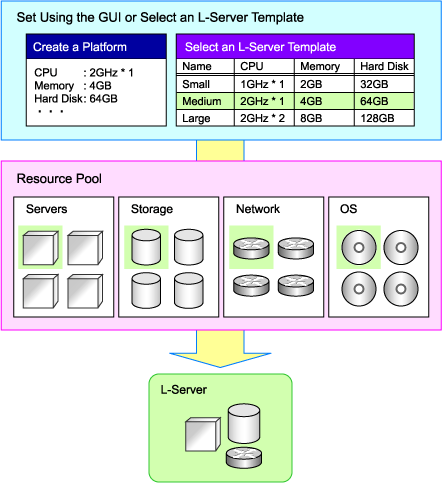Resource Orchestrator can be used to create Logical Servers which define the logical specifications (number of CPUs, memory capacity, disk capacity, number of NICs, etc.) for servers (with storage and networks).
Resources can be allocated to an L-Server according to defined specifications. An L-Server with allocated resources can perform the same operations as a normal physical server and a virtual machine.
In addition, configured physical servers and virtual machines can be managed by linking them with L-Servers.
To operate the server, L-Server users only need to be aware of the specifications defined for the server, and not the resources allocated to it.
The following advantages are gained by using L-Servers:
Simple and rapid server configuration
The ideal server can be configured simply and quickly by automatically allocating resources from resource pools according to the L-Server defined specifications.
Reduced management costs
L-Server users do not need to manage the resources allocated to the server. Moreover, resource management is performed by an infrastructure administrator, reducing overall management costs.
Integrated operation of physical servers and virtual machines
L-Servers can be created for both physical servers and virtual machines.
An L-Server created using a physical server is called a "physical L-Server".
An L-Server created using a virtual machine is called a "virtual L-Server".
After creating L-Servers, operations can be performed without differentiation between physical servers and virtual machines.
Information
Resources from resource pools can be automatically allocated or specific resources can be manually allocated to an L-Server.
L-Server Creation
By specifying server specifications (number of CPUs, memory capacity or model type), storage capacity, operating system image, and network connections, Resource Orchestrator quickly creates a practical L-Server using the applicable resources from resource pools. It is possible to choose from two operational methods: (1) only create the configuration definition of an L-Server. In this case, resources are allocated to it when it is powered on for the first time; (2) create an L-Server with resources allocated. In this case, the L-Server will be ready for use after creation.
Resources can be selected using the following two methods:
Automatic assignment
Specifying resources or resource pools by each user
L-Server specifications can be specified by the following two methods.
Selecting an L-Server template
For details on how to create an L-Server using an L-Server template (with L-Server specifications pre-defined), refer to "10.1 Creation Using an L-Server Template" of the "User's Guide for Infrastructure Administrators (Resource Management) CE".
Manually specifying each L-Server specification without using an L-Server template
For details on how to create an L-Server individually (without using an L-Server template), refer to "10.2 Creation of Physical L-Servers Using Parameters" or "10.3 Creation of Virtual L-Servers Using Parameters" of the "User's Guide for Infrastructure Administrators (Resource Management) CE".
Basic operations, such as startup, shutdown, and delete, can be performed for an L-Server in the same way as for a typical server. L-Server users do not require detailed knowledge of the resources allocated to the server in order to operate it.
The following operations can be performed:
Changing of L-Server configurations
Configurations of resources to allocate to the L-Server can be changed.
Refer to "11.2 Modifying an L-Server" of the "User's Guide for Infrastructure Administrators (Resource Management) CE".
Moving an L-Server between servers (migration) (For virtual L-Servers)
The function that moves a virtual L-Server to another VM host without stopping it.
For details, refer to "11.7 Migration of VM Hosts between Servers" of the "User's Guide for Infrastructure Administrators (Resource Management) CE".
Snapshot (For virtual L-Servers)
The function that saves the content of the system disk and data disk of a virtual L-Server disk at a certain point of time.
For details, refer to "11.6.1 Snapshot" of the "User's Guide for Infrastructure Administrators (Resource Management) CE".
Backup (For physical L-Servers)
The function that saves the system disk of a physical L-Server.
For details, refer to "11.6.2 Backup and Restore" of the "User's Guide for Infrastructure Administrators (Resource Management) CE".
When determining the location of an L-Server, Resource Orchestrator first selects a VM pool.
The VM pool and VM host to use for the L-Server can be selected using the following two methods:
When the VM host on which L-Server will be operated is not specified (when Resource Orchestrator automatically selects the VM host)
When multiple VM pools are accessible, the priority for L-Server creation can be specified for individual VM pools in advance. Resource Orchestrator selects the location from the VM pools, using the order of priority (1 is the highest, 10 lowest). When multiple VM pools have the same priority, the VM pool is selected at random.
When the VM host on which an L-Server will be operated is specified (when Resource Orchestrator creates an L-Server on the specified VM host)
Select the location from the specified VM pools or VM hosts.
Then, determine the VM host on which the L-Server is to be placed.
The destination VM host must meet the following conditions:
The VM host is powered on
Monitoring status is "normal"
Maintenance mode is not set
For details on maintenance mode, refer to "Appendix B Maintenance Mode"" of the "User's Guide for Infrastructure Administrators (Resource Management) CE".
Maintenance mode has not been set for the server virtualization software
When a VM host is specified for "VM host", the capacity of the VM host is checked, and then the L-Server is created.
When using L-Server templates
The VM host on which another L-Server that was created from the same L-Server template is placed is searched for, and then the L-Server is created.
If there is insufficient space on the VM host, a VM host that has more capacity is searched for, and then the L-Server is created.
When not using L-Server templates
A VM host that has more capacity is searched for, and then the L-Server is created.
Figure 1.2 L-Server Creation
